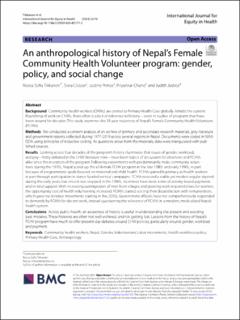| dc.contributor.author | Tikkanen, Roosa Sofia | |
| dc.contributor.author | Closser, Svea | |
| dc.contributor.author | Prince, Justine | |
| dc.contributor.author | Chand, Priyankar | |
| dc.contributor.author | Justice, Judith | |
| dc.date.accessioned | 2024-04-16T09:03:50Z | |
| dc.date.available | 2024-04-16T09:03:50Z | |
| dc.date.created | 2024-04-15T11:48:24Z | |
| dc.date.issued | 2024 | |
| dc.identifier.citation | International Journal for Equity in Health. 2024, 23 (1), 1-18. | en_US |
| dc.identifier.issn | 1475-9276 | |
| dc.identifier.uri | https://hdl.handle.net/11250/3126735 | |
| dc.description.abstract | Background
Community health workers (CHWs) are central to Primary Health Care globally. Amidst the current flourishing of work on CHWs, there often is a lack of reference to history—even in studies of programs that have been around for decades. This study examines the 35-year trajectory of Nepal’s Female Community Health Volunteers (FCHVs).
Methods
We conducted a content analysis of an archive of primary and secondary research materials, grey literature and government reports collected during 1977-2019 across several regions in Nepal. Documents were coded in MAXQDA using principles of inductive coding. As questions arose from the materials, data were triangulated with published sources.
Results
Looking across four decades of the program’s history illuminates that issues of gender, workload, and pay—hotly debated in the CHW literature now—have been topics of discussion for observers and FCHVs alike since the inception of the program. Following experiments with predominantly male community volunteers during the 1970s, Nepal scaled up the all-female FCHV program in the late 1980s and early 1990s, in part because of programmatic goals focused on maternal and child health. FCHVs gained legitimacy as health workers in part through participation in donor-funded vertical campaigns. FCHVs received a stable yet modest regular stipend during the early years, but since it was stopped in the 1990s, incentives have been a mix of activity-based payments and in-kind support. With increasing outmigration of men from villages and growing work responsibilities for women, the opportunity cost of health volunteering increased. FCHVs started voicing their dissatisfaction with remuneration, which gave rise to labor movements starting in the 2010s. Government officials have not comprehensively responded to demands by FCHVs for decent work, instead questioning the relevance of FCHVs in a modern, medicalized Nepali health system.
Conclusions
Across public health, an awareness of history is useful in understanding the present and avoiding past mistakes. These histories are often not well-archived, and risk getting lost. Lessons from the history of Nepal’s FCHV program have much to offer present-day debates around CHW policies, particularly around gender, workload and payment. | en_US |
| dc.language.iso | eng | en_US |
| dc.publisher | BMC | en_US |
| dc.rights | Navngivelse 4.0 Internasjonal | * |
| dc.rights.uri | http://creativecommons.org/licenses/by/4.0/deed.no | * |
| dc.title | An anthropological history of Nepal's Female Community Health Volunteer program: gender, policy, and social change | en_US |
| dc.title.alternative | An anthropological history of Nepal's Female Community Health Volunteer program: gender, policy, and social change | en_US |
| dc.type | Peer reviewed | en_US |
| dc.type | Journal article | en_US |
| dc.description.version | publishedVersion | en_US |
| dc.source.pagenumber | 1-18 | en_US |
| dc.source.volume | 23 | en_US |
| dc.source.journal | International Journal for Equity in Health | en_US |
| dc.source.issue | 1 | en_US |
| dc.identifier.doi | 10.1186/s12939-024-02177-5 | |
| cristin.ispublished | true | |
| cristin.fulltext | original | |
| cristin.qualitycode | 1 | |

